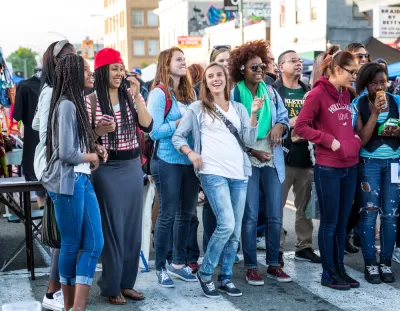Despite the impression that young white people have reshaped cities' demographics, research shows that non-white Millennials account for the greater part of that growth.

In the midst of a debate over "Millennial exodus" from urban cores, William H. Frey points out that the common image of the white Millennial gentrifier doesn't give the whole picture. To begin with, "nearly three-fifths of millennials residing in core urban counties are racial minorities, where more than a quarter are Hispanic, 18 percent are black, and the rest other races."
Moreover, minorities dominate recent urban growth among young adults. "While white millennial gentrification is often cited as a source of youthful urban change, racial minorities were clearly major drivers of young adult growth in all urban and suburban categories in the first half of the decade." In areas closer to the urban core, the trend is even more pronounced.
Looking at the nation's 100 largest metro areas, Frey reports that "Thirty of these areas are 'minority white,' including Miami at 25 percent white and Houston at 32 percent. Several California areas (Los Angeles, Riverside, San Jose, Stockton, Fresno, and Bakersfield) are less than one-third white. Other notable metropolitan areas where whites constitute a minority of millennials are New York City, Atlanta, and Chicago."
"Of the 99 metropolitan areas in which young adult populations grew between 2010-2015 (Birmingham, Ala. took a loss), minorities contributed to more than three quarters of that growth in 51 of them and more than half of the growth in all but 11 of those areas."
FULL STORY: Minorities are the demographic engine of millennial urban growth

Planetizen Federal Action Tracker
A weekly monitor of how Trump’s orders and actions are impacting planners and planning in America.

Congressman Proposes Bill to Rename DC Metro “Trump Train”
The Make Autorail Great Again Act would withhold federal funding to the system until the Washington Metropolitan Area Transit Authority (WMATA), rebrands as the Washington Metropolitan Authority for Greater Access (WMAGA).

DARTSpace Platform Streamlines Dallas TOD Application Process
The Dallas transit agency hopes a shorter permitting timeline will boost transit-oriented development around rail stations.

Renters Now Outnumber Homeowners in Over 200 US Suburbs
High housing costs in city centers and the new-found flexibility offered by remote work are pushing more renters to suburban areas.

The Tiny, Adorable $7,000 Car Turning Japan Onto EVs
The single seat Mibot charges from a regular plug as quickly as an iPad, and is about half the price of an average EV.

Supreme Court Ruling in Pipeline Case Guts Federal Environmental Law
The decision limits the scope of a federal law that mandates extensive environmental impact reviews of energy, infrastructure, and transportation projects.
Urban Design for Planners 1: Software Tools
This six-course series explores essential urban design concepts using open source software and equips planners with the tools they need to participate fully in the urban design process.
Planning for Universal Design
Learn the tools for implementing Universal Design in planning regulations.
Roanoke Valley-Alleghany Regional Commission
City of Mt Shasta
City of Camden Redevelopment Agency
City of Astoria
Transportation Research & Education Center (TREC) at Portland State University
US High Speed Rail Association
City of Camden Redevelopment Agency
Municipality of Princeton (NJ)





























